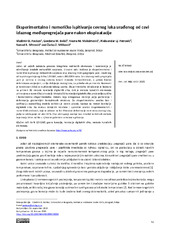Приказ основних података о документу
Experimental and numerical analyses of an U-bend tube made of an output inter-heater tube after exploitation
| dc.creator | Pavkov, Vladimir | |
| dc.creator | Bakić, Gordana | |
| dc.creator | Maksimović, Vesna | |
| dc.creator | Petrović, Aleksandar | |
| dc.creator | Mitrović, Nenad | |
| dc.creator | Mišković, Žarko | |
| dc.date.accessioned | 2022-09-19T18:59:01Z | |
| dc.date.available | 2022-09-19T18:59:01Z | |
| dc.date.issued | 2020 | |
| dc.identifier.issn | 0367-598X | |
| dc.identifier.uri | https://machinery.mas.bg.ac.rs/handle/123456789/3286 | |
| dc.description.abstract | One of the important tasks of evaluating the integrity of mechanical process elements and structures is to determine the local mechanical properties. In this paper, experimental and numerical analyses of the mechanical behavior of an output inter-heater tube, made of 12H1MF heat-resistant steel, was performed after 200,000 h of exploitation. During exploitation, the tube was exposed to various mechanisms of damage including gas corrosion. The tube was cut from a pipe system during reparations of a thermal power plant, and then cold-deformed by bending to obtain a U-bend tube, which was then used in the experiment. For this purpose, a specimen holder made of structural steel S235 was specifically designed to test such a sample. The U-bend tube was then exposed to the external compressive load during the experiment. Experimental research was based on the application of the 3D digital image correlation (DIC), while a finite element method (FEM) was applied in numerical simulation performed by using the Abaqus software package. The 3D DIC is an optical and contactless experimental method that allows measurements of displacement fields and deformations of geometrically complex structures. The Aramis system was used for the experimental analysis as well as for verification of the numerical model. During the experiment, the von Mises strain field was measured at the top of the U-bend tube, in the tightening zone, as it represents a critical place for crack initiation and propagation during the work of an inter-heater. Based on the obtained results and a comparative analysis of experimental and numerical values of the von Mises strain field at the U-bend tube, deviation of the model predictions of about 18 % was determined. The FEM predicted smaller values of the von Mises strain field compared to the DIC method. This is the result of an incomplete geometry applied in the model due to deformation that occurred in the bend zone of the U-bend tube, loss of material and the tube surface damage due to the influence of gas corrosion during 200,000 h of exploitation. Experimental analysis has confirmed that the U-bend tube, after 200,000 h of exploitation, can remain in service even if it is damaged due to the effect of gas corrosion. | en |
| dc.publisher | Savez hemijskih inženjera, Beograd | |
| dc.relation | info:eu-repo/grantAgreement/MESTD/Technological Development (TD or TR)/35024/RS// | |
| dc.rights | openAccess | |
| dc.rights.uri | https://creativecommons.org/licenses/by-nc-nd/4.0/ | |
| dc.source | Hemijska Industrija | |
| dc.subject | steel 12H1MF | en |
| dc.subject | gas corrosion | en |
| dc.subject | finite element method | en |
| dc.subject | digital image correlation | en |
| dc.title | Experimental and numerical analyses of an U-bend tube made of an output inter-heater tube after exploitation | en |
| dc.type | article | |
| dc.rights.license | BY-NC-ND | |
| dc.citation.epage | 63 | |
| dc.citation.issue | 1 | |
| dc.citation.other | 74(1): 51-63 | |
| dc.citation.rank | M23 | |
| dc.citation.spage | 51 | |
| dc.citation.volume | 74 | |
| dc.identifier.doi | 10.2298/HEMIND190905005P | |
| dc.identifier.fulltext | http://machinery.mas.bg.ac.rs/bitstream/id/1909/3283.pdf | |
| dc.identifier.scopus | 2-s2.0-85081198637 | |
| dc.identifier.wos | 000518443600005 | |
| dc.type.version | publishedVersion |


